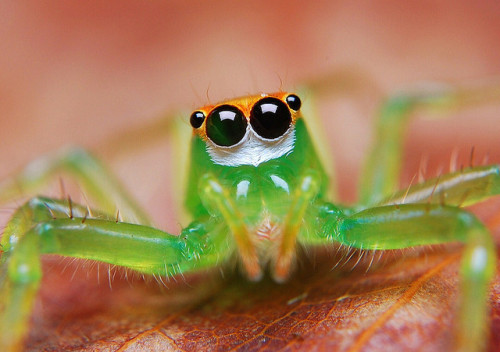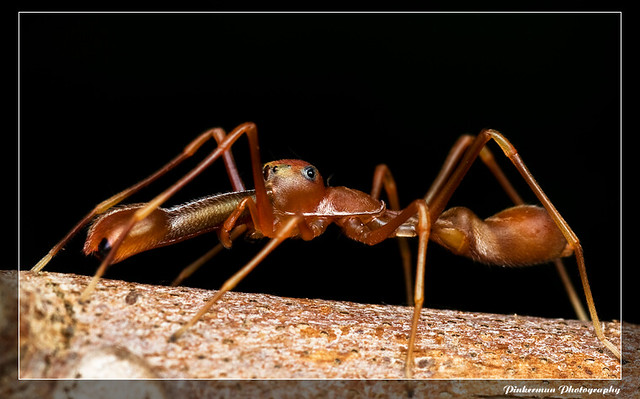Today's long-delayed post is nothing short of a shameless excuse to peruse some of the best Macro-photography on Salticids present on the web. I will take you on a guided tour of some of the best shots I know of and hopefully even help identify some of what your looking at in the photos. After all, knowledge only makes things more appealing and interesting! Just by way of disclaimer, none of the following images are mine, and the species labels, while educated guesses, should not be treated a positive identifications as the specimen was not available for me to key out properly.
Our first photo is a lovely close up of a Phidippus species. This specimen is likely from the species P. mystaceus, given the extremely large black tufts around the eyes and the bright yellow legs.
 |
| Borrowed from http://25.media.tumblr.com/tumblr_lvys4wWKLO1r3p20do1_500.jpg |
Our next lovely model is almost certainly from the genus Lysomannes as there are very few other salticids with such a bright green complexion.These tiny salticids are known for their ability to jump very well (even for a salticid) and frequently catch flying prey by pouncing on it mid-air as it flies by!
 |
| Borrowed from http://24.media.tumblr.com/tumblr_mc8xsb5Oo51rob773o1_500.jpg |
This lovely ant is... wait a minute, that's no ant, its a salticid in disguise! If you take a very close look, you can see the telltale signs that we have a myrmecomorph (ant-mimicking spider) on our hands! While I am unsure as to the species, or even the Genus of the animal, I think we can all agree that it does a remarkable job of looking like its intended victims. Many species that adopt this form of mimicry feed on ants and even live in the nests of those they hunt. However, there are also mimics that only use the ants for protection and either steal food from them or else specialize in foraging near ant lines and colonies. A fascinating way to outsmart one of the salticids most dangerous enemies!
 |
| Borrowed from http://farm5.staticflickr.com/4149/5050635255_aa3abe82a8_z.jpg |
Our final red-faced friend is from the Genus Habronattus. The photographer has identified the animal as H. americanus. Habronattus are generally tiny animals and are frequently no more than a few millimeters in length. They are also quite adept at jumping, much more so than this counterparts in the genus Phidippus.
 |
| Borrowed from http://bugs.adrianthysse.com/wp-content/uploads/2013/08/Habronattus-americanus-21-04-2013-5-31-36-PM.jpg |
I hope you've enjoyed this brief macro tour of salticids. For the next post, I'm planning something a bit more meaty in terms of content, but every so often its nice to have fun with these beautiful animals. As the Summer draws to a close, I encourage you to go out and enjoy these amazing little animals one last time before winter sends them scurrying for a long, and undoubtedly well deserved, nap.Happy watching!